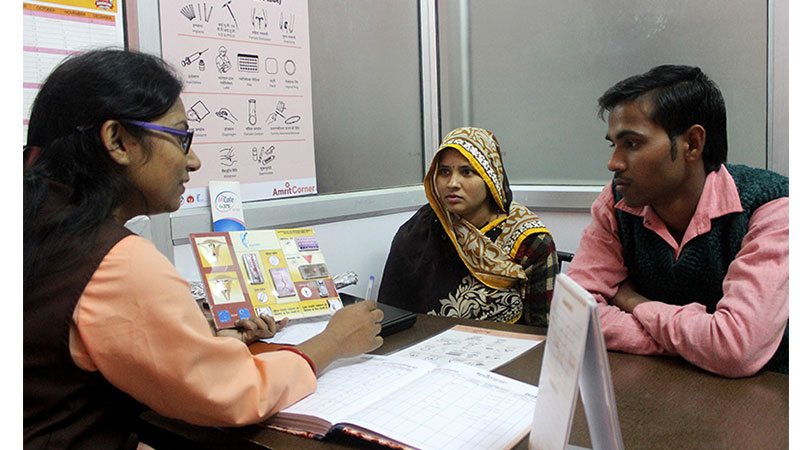Family Planning and Contraception
There is a wide basket of choices when it comes to contraception and at Dhanvantari, hospital Mumbai, you are given full choice between the most appropriate ones only for you! Various choices are available. Gynecologist, Dr. Deepika Doshi is known for painless insertion of Copper T at Dhanvantari Hospital in Borivali.
A. Intrauterine Device (IUD)
- Copper T intrauterine device (IUD): This IUD is a small device that is shaped in the form of a “T " and placed inside the uterus to prevent pregnancy. It can stay in your uterus for up to 10 years. Typical use failure rate: 0.8%. Contact Copper T gynac in Borivali.
- Levonorgestrel intrauterine system (LNG IUD)(MIRENA): The LNG IUD is also a small T-shaped device that releases a small amount of progestin each day to keep you from getting pregnant. The LNG IUD stays in your uterus for up to 5 years. Typical use failure rate: 0.2%.
B. Hormonal Methods
- Implant: The implant is a single, thin rod that is inserted under the skin of a women’s upper arm. The rod contains a progestin that is released into the body over 3 years. Typical use failure rate: 0.05%.
- DMPA Injection or “shot" Women get shots of the hormone progestin in the buttocks or arm every three months. Typical use failure rate: 6%.
- Birth Control Pills
- Combined oral contraceptives: Contain the hormones estrogen and progestin. If you are older than 35 years and smoke, have a history of blood clots or breast cancer, pills are usually not advised. Typical use failure rate: 9%.
- Progestin only Pill: Unlike the combined pill, the progestin-only pill (sometimes called the mini-pill) only has one hormone, progestin, instead of both estrogen and progestin. It may be a good option for women who can’t take estrogen. Typical use failure rate: 9%.
- Patch: This skin patch is worn on the lower abdomen, buttocks, or upper body (but not on the breasts). It releases hormones progestin and estrogen into the bloodstream. You put on a new patch once a week for three weeks. During the fourth week, you do not wear a patch, so you can have a menstrual period. Typical use failure rate: 9%
- Hormonal vaginal contraceptive ring (NOVA): The ring releases the hormones progestin and estrogen. You place the ring inside your vagina. You wear the ring for three weeks, take it out for the week you have your period, and then put in a new ring. Typical use failure rate: 9%.Emergency contraception— This is used after no birth control was used during sex, or if the birth control method failed, such as if a condom broke. Women can have the Copper T IUD inserted within five days of unprotected sex. Women can take emergency contraceptive pills up to 5 days after unprotected sex, but the sooner the pills are taken, the better they will work.
C. Barrier Methods
- Diaphragm Or Cervical Cap: Each of these barrier methods is placed inside the vagina to cover the cervix to block sperm. The diaphragm is shaped like a shallow cup. The cervical cap is a thimble-shaped cup. Before sexual intercourse, you insert them with spermicide to block or kill sperm. Typical use failure rate: 12%.
- Male Condom: A male condom keeps sperm from getting into a woman’s body. Latex condoms, the most common type, help prevent pregnancy, and HIV and other STDs, as do the newer synthetic condoms. “Natural” or “lambskin” condoms also help prevent pregnancy, but may not provide protection against STDs, including HIV. Typical use failure rate: 18%.
- Female Condom: Worn by the woman, the female condom helps keeps sperm from getting into her body. It is packaged with a lubricant and is available at drug stores. It can be inserted up to eight hours before sexual intercourse. Typical use failure rate: 21%, and also may help prevent STDs.
- Spermicides: These products work by killing sperm and come in several forms-foam, gel, cream, film, suppository, or tablet. They are placed in the vagina no more than one hour before intercourse. You leave them in place at least six to eight hours after intercourse. You can use a spermicide in addition to a male condom, diaphragm, or cervical cap. Typical use failure rate: 28%.
- Natural Family Planning Or Fertility Awareness: If you have a regular menstrual cycle, you have about nine or more fertile days each month. If you do not want to get pregnant, you do not have sex on the days you are fertile, or you use a barrier method of birth control on those days. Failure rates vary across these methods. Overall, the typical use failure rate: 24%.
- Female Sterilization Tubal ligation or “tying tubes”— A woman can have her fallopian tubes tied (or closed) so that sperm and eggs cannot meet for fertilization. The procedure is done under anesthesia. This method is effective immediately.
Get a free consultation about family planning and Contraception. Book an appointment with Dr. Deepika Doshi

